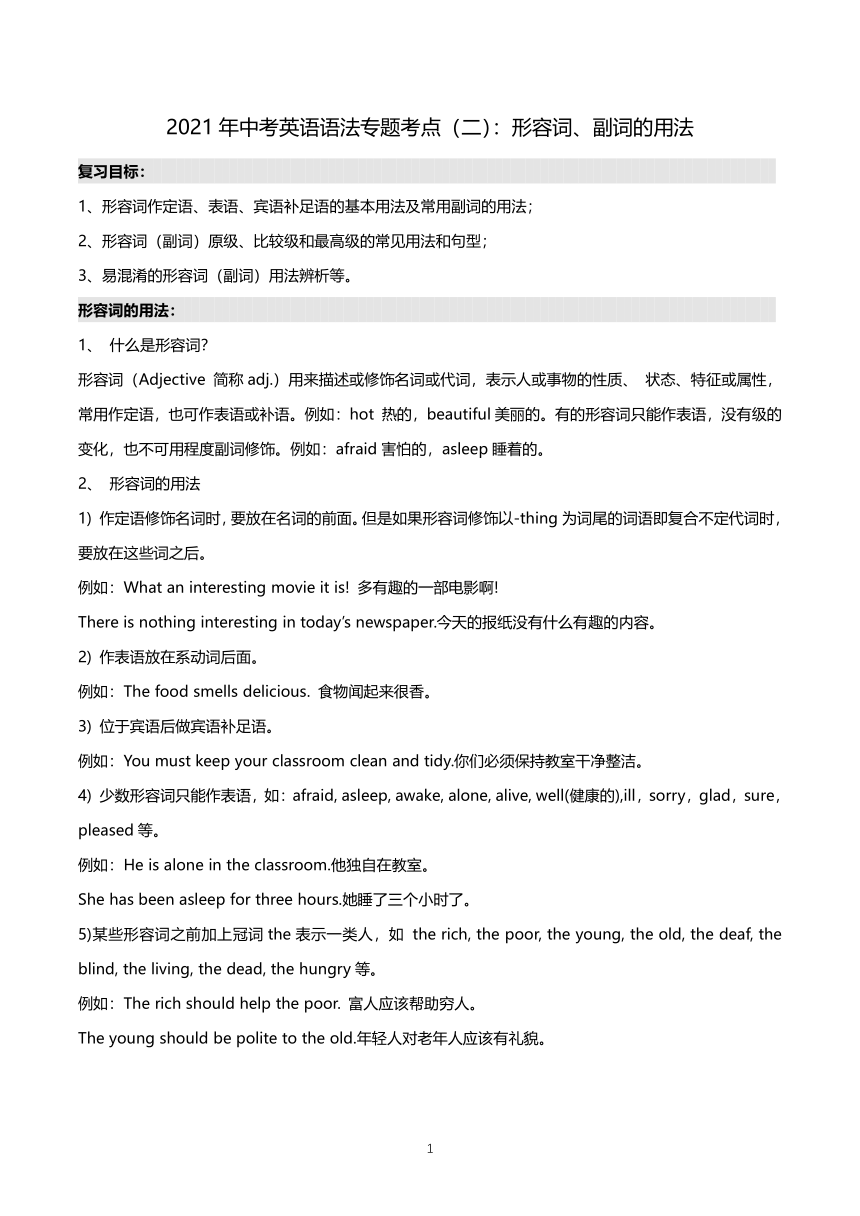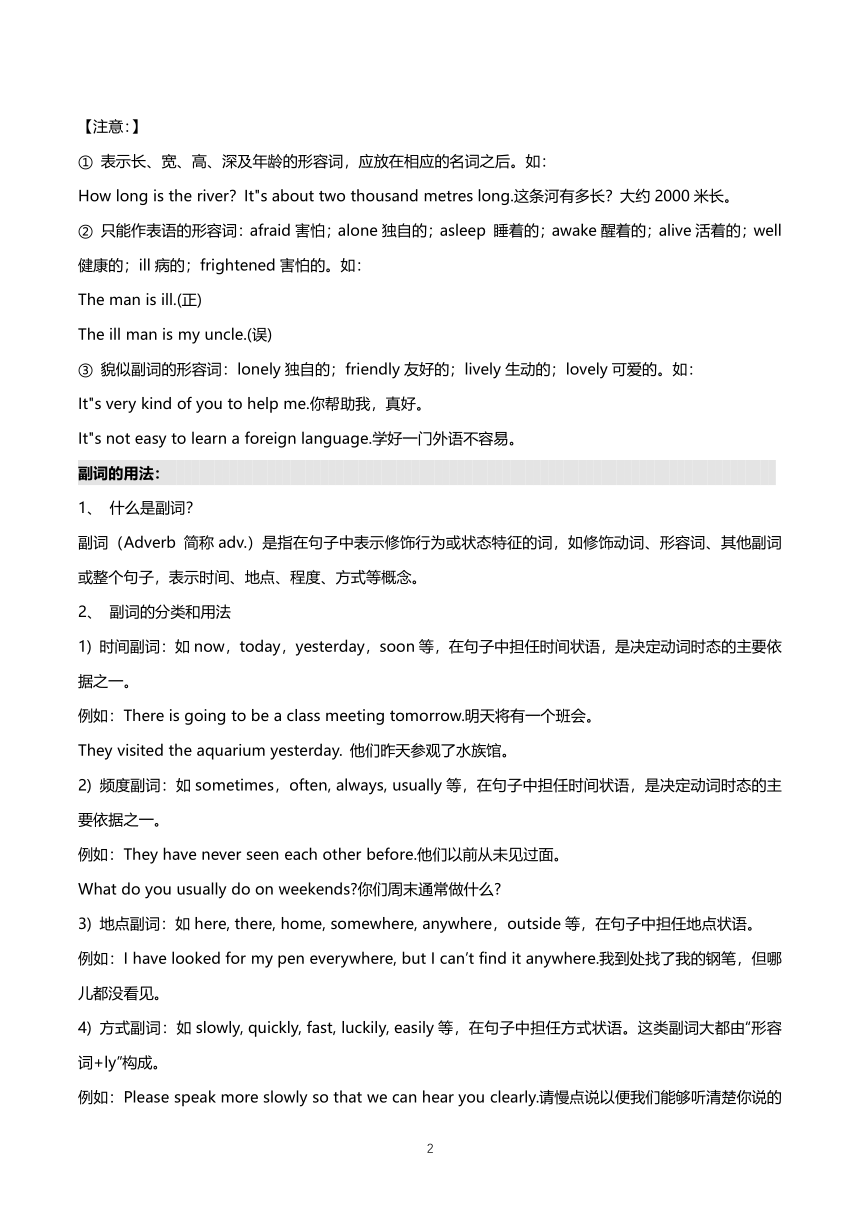2020学年中考英语语法专题复习 考点(二):形容词、副词的用法
文档属性
| 名称 | 2020学年中考英语语法专题复习 考点(二):形容词、副词的用法 |  | |
| 格式 | docx | ||
| 文件大小 | 20.4KB | ||
| 资源类型 | 教案 | ||
| 版本资源 | 人教新目标(Go for it)版 | ||
| 科目 | 英语 | ||
| 更新时间 | 2020-10-25 21:38:29 | ||
图片预览


文档简介
2021年中考英语语法专题考点(二):形容词、副词的用法
复习目标:
1、形容词作定语、表语、宾语补足语的基本用法及常用副词的用法;
2、形容词(副词)原级、比较级和最高级的常见用法和句型;
3、易混淆的形容词(副词)用法辨析等。
形容词的用法:
1、
什么是形容词?
形容词(Adjective
简称adj.)用来描述或修饰名词或代词,表示人或事物的性质、
状态、特征或属性,常用作定语,也可作表语或补语。例如:hot
热的,beautiful美丽的。有的形容词只能作表语,没有级的变化,也不可用程度副词修饰。例如:afraid害怕的,asleep睡着的。
2、
形容词的用法
1)
作定语修饰名词时,要放在名词的前面。但是如果形容词修饰以-thing为词尾的词语即复合不定代词时,要放在这些词之后。
例如:What
an
interesting
movie
it
is!
多有趣的一部电影啊!
There
is
nothing
interesting
in
today’s
newspaper.今天的报纸没有什么有趣的内容。
2)
作表语放在系动词后面。
例如:The
food
smells
delicious.
食物闻起来很香。
3)
位于宾语后做宾语补足语。
例如:You
must
keep
your
classroom
clean
and
tidy.你们必须保持教室干净整洁。
4)
少数形容词只能作表语,如:afraid,
asleep,
awake,
alone,
alive,
well(健康的),ill,sorry,glad,sure,pleased等。
例如:He
is
alone
in
the
classroom.他独自在教室。
She
has
been
asleep
for
three
hours.她睡了三个小时了。
5)某些形容词之前加上冠词the表示一类人,如
the
rich,
the
poor,
the
young,
the
old,
the
deaf,
the
blind,
the
living,
the
dead,
the
hungry等。
例如:The
rich
should
help
the
poor.
富人应该帮助穷人。
The
young
should
be
polite
to
the
old.年轻人对老年人应该有礼貌。
【注意:】
①
表示长、宽、高、深及年龄的形容词,应放在相应的名词之后。如:
How
long
is
the
river?It"s
about
two
thousand
metres
long.这条河有多长?大约2000米长。
②
只能作表语的形容词:afraid害怕;alone独自的;asleep
睡着的;awake醒着的;alive活着的;well健康的;ill病的;frightened害怕的。如:
The
man
is
ill.(正)
The
ill
man
is
my
uncle.(误)
③
貌似副词的形容词:lonely独自的;friendly友好的;lively生动的;lovely可爱的。如:
It"s
very
kind
of
you
to
help
me.你帮助我,真好。
It"s
not
easy
to
learn
a
foreign
language.学好一门外语不容易。
副词的用法:
1、
什么是副词?
副词(Adverb
简称adv.)是指在句子中表示修饰行为或状态特征的词,如修饰动词、形容词、其他副词或整个句子,表示时间、地点、程度、方式等概念。
2、
副词的分类和用法
1)
时间副词:如now,today,yesterday,soon等,在句子中担任时间状语,是决定动词时态的主要依据之一。
例如:There
is
going
to
be
a
class
meeting
tomorrow.明天将有一个班会。
They
visited
the
aquarium
yesterday.
他们昨天参观了水族馆。
2)
频度副词:如sometimes,often,
always,
usually等,在句子中担任时间状语,是决定动词时态的主要依据之一。
例如:They
have
never
seen
each
other
before.他们以前从未见过面。
What
do
you
usually
do
on
weekends?你们周末通常做什么?
3)
地点副词:如here,
there,
home,
somewhere,
anywhere,outside等,在句子中担任地点状语。
例如:I
have
looked
for
my
pen
everywhere,
but
I
can’t
find
it
anywhere.我到处找了我的钢笔,但哪儿都没看见。
4)
方式副词:如slowly,
quickly,
fast,
luckily,
easily等,在句子中担任方式状语。这类副词大都由“形容词+ly”构成。
例如:Please
speak
more
slowly
so
that
we
can
hear
you
clearly.请慢点说以便我们能够听清楚你说的内容。
5)
程度副词:如very,
quite,
rather,
too,
much,
so等,在句子中修饰形容词或其他副词,作状语。
例如:It’s
much
too
hot
in
Changsha
these
days.这些天长沙太热了。
The
little
boy
can
play
the
guitar
very
well.这小男孩吉他弹得非常好。
6)
疑问副词:如when,
where,
why,
how,
how
long,
how
soon,
how
often,
how
far,how
old等,放在句首构成特殊疑问句。
例如:How
soon
will
your
father
be
back
home?
你爸过多久回到家?
How
often
do
you
go
to
the
movie?
你们隔多久看一次电影?
7)
关系副词:如when,
where,
why,
how等,用来引导相关从句。
例如:What
were
you
doing
when
the
UFO
landed?
UFO着陆时你在干什么?
I
‘d
like
to
go
somewhere
where
people
are
friendly.
我想去人们友好的地方。
3、副词的位置
总的来说,很多副词的位置比较灵活,在句子开头、中间、结尾都可以。但是请注意下面几点:
1)
频度副词作状语时放在be动词、助动词、情态动词之后,行为动词之前。
例如:He
is
never
late
for
school.他上学从不迟到。
He
usually
goes
to
see
his
grandparents
on
Saturday.
他通常周六去看望爷爷奶奶。
2)
enough修饰形容词或副词时要放在被修饰词的后面。
例如:The
little
boy
isn’t
old
enough
to
go
to
school.
小男孩没到上学的年龄。
He
ran
fast
enough
to
catch
the
thief.
他跑得够快,抓住了小偷。
形容词
(副词)
等级的用法:
1.形容词、副词比较级和最高级的构成
①规则变化
构成方法
原级
比较级
最高级
(1)一般单音节词末尾加-er,-est
,
如:small→smaller→
smallest
fast→faster→fastest
quick→quicker→quickest
(2)以不发音的e结尾的单音节词末尾加-r,-st
如:nice→nicer
→nicest
fine→finer→finest
(3)以辅音字母+y结尾的双音节单词,先把y变为i,再加-er,-est
如:lonely→lonelier
→loneliest
happy→happier→happiest
(4)以一个辅音字母结尾的重读闭音节单词,双写末尾的字母再加-er,-est
如:hot→hotter→hottest
big→bigger→biggest
thin→thinner
→thinnest
(5)部分双音节词或多音节词在原级前加more,most
如:interesting→more
interesting
→most
interesting
tired
→more
tired→most
tired
②不规则变化
原级
比较级
最高级
good/well
→
better
→
best
bad/ill/badly
→
worse
→
worst
little
→
less
→
least
many/much
→
more
→
most
far
→
farther
→
farthest
old
→
older/elder
→
oldest/eldest
③下列单、双音节词只能加more和most
原级
比较级
最高级
like(相似的,同样的)
→
more
like
→
most
like
real(真的)
→
more
real
→
most
real
tired(疲乏的)
→
more
tired
→most
tired
pleased(高兴的)
→
more
pleased
→
most
pleased
often(经常)
→
more
often
→most
often
2.形容词、副词等级的用法
?
原级的用法
①
只能修饰原级的词:very,quite,so,too,rather。如:He
is
too
tired
to
walk
on.他太累了以至于不能再继续走了。
②
as...as...和……一样(中间用原级)
not
as(so)...as和……不一样(中间用原级) 如:Tom
is
as
old
as
Kate.汤姆和凯特年龄一样大。
Tom
is
twice
as
old
as
Kate.汤姆的年龄是凯特的两倍。
This
room
is
not
so/as
big
as
that
one.这个房间不如那个大。
?
比较级的用法
①可以修饰比较级的词:much,a
lot,far,a
little,a
bit,even,still。
②
...than……比……
如:Tom
is
taller
than
Kate.汤姆比凯特高。
③
选择疑问句中,二选一时
如:Which
is
bigger,the
earth
or
the
moon?哪一个更大,地球还是月球?
④
用比较级表示最高级的意思
如:The
Yangtze
River
is
longer
than
any
other
river
in
China.在中国,长江比其他任何一条河都长。
⑤
“比较级+and+比较级”表示“越来越……”
如:He
is
getting
taller
and
taller.他变得越来越高了。
The
flowers
are
more
and
more
beautiful.花儿越来越漂亮了。
⑥
“the+比较级,the+比较级”表示“越……,就越……”
如:The
more
careful
you
are,the
fewer
mistakes
you"ll
make.你越认真,犯的错误就越少。
⑦
在比较级中为了避免重复,在than后常用one,that,those等词来替代前面提到过的名词。
如:The
weather
here
is
warmer
than
that
in
Shanghai.这里的天气比上海的暖和。
⑧
表示倍数的比较
如:This
room
is
three
times
bigger
than
that
one.这个房间比那个大3倍。
?
最高级的用法
①
形容词最高级前一定要用the,副词最高级前可省略the。
②
有范围(in,of,among或从句等)修饰的用最高级。
如:Winter
is
the
coldest
season
of
the
year.冬季是一年里最冷的季节。
This
is
the
best
film
that
I
have
ever
seen.这是我所看过的最好的电影。
③
“主语+be+one
of
the+形容词最高级+复数名词+in/of短语”表示“……是……中最……之一”。
如:Beijing
is
one
of
the
largest
cities
in
China.北京是中国最大的城市之一。
④
选择疑问句中用于三者或三者以上的比较。
如:Which
country
is
the
largest,China,Brazil
or
Canada?哪一个国家最大,中国,巴西还是加拿大?
Which
season
do
you
like
(the)
best,spring,summer
or
autumn?你最喜欢哪一个季节,春天,夏天还是秋天?
⑤
表示“第几个最……”时,用“the+序数词+最高级+名词单数”的结构。
如:The
Yellow
River
is
the
second
longest
river
in
China.黄河是中国第二长河。
4
复习目标:
1、形容词作定语、表语、宾语补足语的基本用法及常用副词的用法;
2、形容词(副词)原级、比较级和最高级的常见用法和句型;
3、易混淆的形容词(副词)用法辨析等。
形容词的用法:
1、
什么是形容词?
形容词(Adjective
简称adj.)用来描述或修饰名词或代词,表示人或事物的性质、
状态、特征或属性,常用作定语,也可作表语或补语。例如:hot
热的,beautiful美丽的。有的形容词只能作表语,没有级的变化,也不可用程度副词修饰。例如:afraid害怕的,asleep睡着的。
2、
形容词的用法
1)
作定语修饰名词时,要放在名词的前面。但是如果形容词修饰以-thing为词尾的词语即复合不定代词时,要放在这些词之后。
例如:What
an
interesting
movie
it
is!
多有趣的一部电影啊!
There
is
nothing
interesting
in
today’s
newspaper.今天的报纸没有什么有趣的内容。
2)
作表语放在系动词后面。
例如:The
food
smells
delicious.
食物闻起来很香。
3)
位于宾语后做宾语补足语。
例如:You
must
keep
your
classroom
clean
and
tidy.你们必须保持教室干净整洁。
4)
少数形容词只能作表语,如:afraid,
asleep,
awake,
alone,
alive,
well(健康的),ill,sorry,glad,sure,pleased等。
例如:He
is
alone
in
the
classroom.他独自在教室。
She
has
been
asleep
for
three
hours.她睡了三个小时了。
5)某些形容词之前加上冠词the表示一类人,如
the
rich,
the
poor,
the
young,
the
old,
the
deaf,
the
blind,
the
living,
the
dead,
the
hungry等。
例如:The
rich
should
help
the
poor.
富人应该帮助穷人。
The
young
should
be
polite
to
the
old.年轻人对老年人应该有礼貌。
【注意:】
①
表示长、宽、高、深及年龄的形容词,应放在相应的名词之后。如:
How
long
is
the
river?It"s
about
two
thousand
metres
long.这条河有多长?大约2000米长。
②
只能作表语的形容词:afraid害怕;alone独自的;asleep
睡着的;awake醒着的;alive活着的;well健康的;ill病的;frightened害怕的。如:
The
man
is
ill.(正)
The
ill
man
is
my
uncle.(误)
③
貌似副词的形容词:lonely独自的;friendly友好的;lively生动的;lovely可爱的。如:
It"s
very
kind
of
you
to
help
me.你帮助我,真好。
It"s
not
easy
to
learn
a
foreign
language.学好一门外语不容易。
副词的用法:
1、
什么是副词?
副词(Adverb
简称adv.)是指在句子中表示修饰行为或状态特征的词,如修饰动词、形容词、其他副词或整个句子,表示时间、地点、程度、方式等概念。
2、
副词的分类和用法
1)
时间副词:如now,today,yesterday,soon等,在句子中担任时间状语,是决定动词时态的主要依据之一。
例如:There
is
going
to
be
a
class
meeting
tomorrow.明天将有一个班会。
They
visited
the
aquarium
yesterday.
他们昨天参观了水族馆。
2)
频度副词:如sometimes,often,
always,
usually等,在句子中担任时间状语,是决定动词时态的主要依据之一。
例如:They
have
never
seen
each
other
before.他们以前从未见过面。
What
do
you
usually
do
on
weekends?你们周末通常做什么?
3)
地点副词:如here,
there,
home,
somewhere,
anywhere,outside等,在句子中担任地点状语。
例如:I
have
looked
for
my
pen
everywhere,
but
I
can’t
find
it
anywhere.我到处找了我的钢笔,但哪儿都没看见。
4)
方式副词:如slowly,
quickly,
fast,
luckily,
easily等,在句子中担任方式状语。这类副词大都由“形容词+ly”构成。
例如:Please
speak
more
slowly
so
that
we
can
hear
you
clearly.请慢点说以便我们能够听清楚你说的内容。
5)
程度副词:如very,
quite,
rather,
too,
much,
so等,在句子中修饰形容词或其他副词,作状语。
例如:It’s
much
too
hot
in
Changsha
these
days.这些天长沙太热了。
The
little
boy
can
play
the
guitar
very
well.这小男孩吉他弹得非常好。
6)
疑问副词:如when,
where,
why,
how,
how
long,
how
soon,
how
often,
how
far,how
old等,放在句首构成特殊疑问句。
例如:How
soon
will
your
father
be
back
home?
你爸过多久回到家?
How
often
do
you
go
to
the
movie?
你们隔多久看一次电影?
7)
关系副词:如when,
where,
why,
how等,用来引导相关从句。
例如:What
were
you
doing
when
the
UFO
landed?
UFO着陆时你在干什么?
I
‘d
like
to
go
somewhere
where
people
are
friendly.
我想去人们友好的地方。
3、副词的位置
总的来说,很多副词的位置比较灵活,在句子开头、中间、结尾都可以。但是请注意下面几点:
1)
频度副词作状语时放在be动词、助动词、情态动词之后,行为动词之前。
例如:He
is
never
late
for
school.他上学从不迟到。
He
usually
goes
to
see
his
grandparents
on
Saturday.
他通常周六去看望爷爷奶奶。
2)
enough修饰形容词或副词时要放在被修饰词的后面。
例如:The
little
boy
isn’t
old
enough
to
go
to
school.
小男孩没到上学的年龄。
He
ran
fast
enough
to
catch
the
thief.
他跑得够快,抓住了小偷。
形容词
(副词)
等级的用法:
1.形容词、副词比较级和最高级的构成
①规则变化
构成方法
原级
比较级
最高级
(1)一般单音节词末尾加-er,-est
,
如:small→smaller→
smallest
fast→faster→fastest
quick→quicker→quickest
(2)以不发音的e结尾的单音节词末尾加-r,-st
如:nice→nicer
→nicest
fine→finer→finest
(3)以辅音字母+y结尾的双音节单词,先把y变为i,再加-er,-est
如:lonely→lonelier
→loneliest
happy→happier→happiest
(4)以一个辅音字母结尾的重读闭音节单词,双写末尾的字母再加-er,-est
如:hot→hotter→hottest
big→bigger→biggest
thin→thinner
→thinnest
(5)部分双音节词或多音节词在原级前加more,most
如:interesting→more
interesting
→most
interesting
tired
→more
tired→most
tired
②不规则变化
原级
比较级
最高级
good/well
→
better
→
best
bad/ill/badly
→
worse
→
worst
little
→
less
→
least
many/much
→
more
→
most
far
→
farther
→
farthest
old
→
older/elder
→
oldest/eldest
③下列单、双音节词只能加more和most
原级
比较级
最高级
like(相似的,同样的)
→
more
like
→
most
like
real(真的)
→
more
real
→
most
real
tired(疲乏的)
→
more
tired
→most
tired
pleased(高兴的)
→
more
pleased
→
most
pleased
often(经常)
→
more
often
→most
often
2.形容词、副词等级的用法
?
原级的用法
①
只能修饰原级的词:very,quite,so,too,rather。如:He
is
too
tired
to
walk
on.他太累了以至于不能再继续走了。
②
as...as...和……一样(中间用原级)
not
as(so)...as和……不一样(中间用原级) 如:Tom
is
as
old
as
Kate.汤姆和凯特年龄一样大。
Tom
is
twice
as
old
as
Kate.汤姆的年龄是凯特的两倍。
This
room
is
not
so/as
big
as
that
one.这个房间不如那个大。
?
比较级的用法
①可以修饰比较级的词:much,a
lot,far,a
little,a
bit,even,still。
②
...than……比……
如:Tom
is
taller
than
Kate.汤姆比凯特高。
③
选择疑问句中,二选一时
如:Which
is
bigger,the
earth
or
the
moon?哪一个更大,地球还是月球?
④
用比较级表示最高级的意思
如:The
Yangtze
River
is
longer
than
any
other
river
in
China.在中国,长江比其他任何一条河都长。
⑤
“比较级+and+比较级”表示“越来越……”
如:He
is
getting
taller
and
taller.他变得越来越高了。
The
flowers
are
more
and
more
beautiful.花儿越来越漂亮了。
⑥
“the+比较级,the+比较级”表示“越……,就越……”
如:The
more
careful
you
are,the
fewer
mistakes
you"ll
make.你越认真,犯的错误就越少。
⑦
在比较级中为了避免重复,在than后常用one,that,those等词来替代前面提到过的名词。
如:The
weather
here
is
warmer
than
that
in
Shanghai.这里的天气比上海的暖和。
⑧
表示倍数的比较
如:This
room
is
three
times
bigger
than
that
one.这个房间比那个大3倍。
?
最高级的用法
①
形容词最高级前一定要用the,副词最高级前可省略the。
②
有范围(in,of,among或从句等)修饰的用最高级。
如:Winter
is
the
coldest
season
of
the
year.冬季是一年里最冷的季节。
This
is
the
best
film
that
I
have
ever
seen.这是我所看过的最好的电影。
③
“主语+be+one
of
the+形容词最高级+复数名词+in/of短语”表示“……是……中最……之一”。
如:Beijing
is
one
of
the
largest
cities
in
China.北京是中国最大的城市之一。
④
选择疑问句中用于三者或三者以上的比较。
如:Which
country
is
the
largest,China,Brazil
or
Canada?哪一个国家最大,中国,巴西还是加拿大?
Which
season
do
you
like
(the)
best,spring,summer
or
autumn?你最喜欢哪一个季节,春天,夏天还是秋天?
⑤
表示“第几个最……”时,用“the+序数词+最高级+名词单数”的结构。
如:The
Yellow
River
is
the
second
longest
river
in
China.黄河是中国第二长河。
4
同课章节目录
- 词法
- 名词
- 动词和动词短语
- 动词语态
- 动词时态
- 助动词和情态动词
- 非谓语动词
- 冠词
- 代词
- 数词和量词
- 形容词副词及其比较等级
- 介词和介词短语
- 连词和感叹词
- 构词法
- 相似、相近词比较
- 句法
- 陈述句
- 一般疑问句和否定疑问句
- 特殊疑问句及选择疑问句
- 反意疑问句
- 存在句(There be句型)
- 宾语从句
- 定语从句
- 状语从句
- 主谓一致问题
- 简单句
- 并列句
- 复合句
- 主谓一致
- 主、表语从句
- 名词性从句
- 直接引语和间接引语
- 虚拟语气
- 感叹句
- 强调句
- 倒装句
- 祈使句
- 句子的成分
- 句子的分类
- 题型专区
- 单项选择部分
- 易错题
- 完形填空
- 阅读理解
- 词汇练习
- 听说训练
- 句型转换
- 补全对话
- 短文改错
- 翻译
- 书面表达
- 任务型阅读
- 语法填空
- 其他资料
